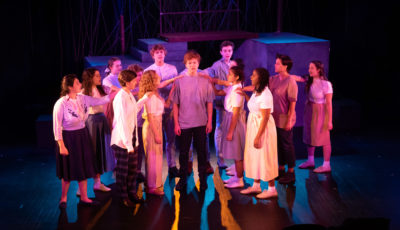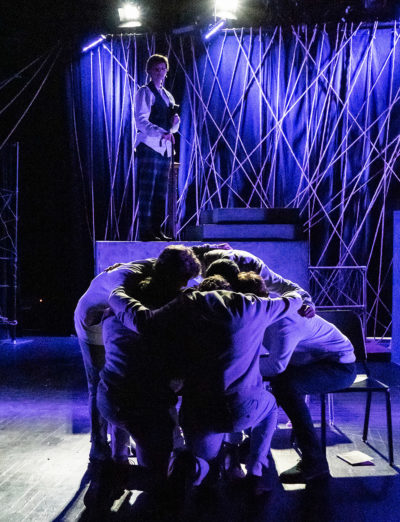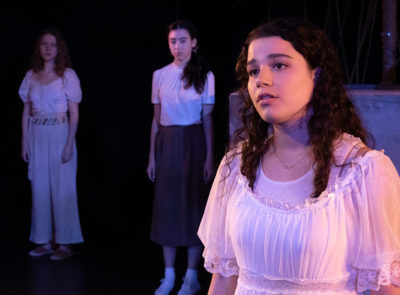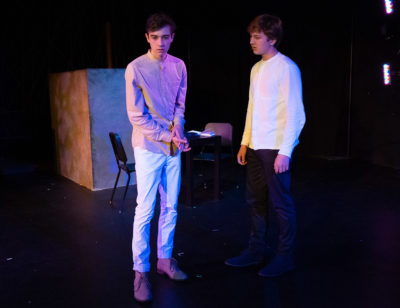For over 50 years, the Oakwood Theatre Department has produced challenging plays that don’t shy away from controversial or difficult subject matter. In the words of Sabell Bender, who led Oakwood’s Theatre program for over two decades, plays have the potential to “give young people the faith to make ‘what is’ better,” and she considered the opportunity to confront conflict as “the essence of theatre.” From classics like Cabaret and Fiddler on the Roof, to a 2015 12th grade production of Lanford Wilson’s The Hot L Baltimore, Oakwood students have embraced this challenge. This winter, Oakwood students carried this legacy on with Spring Awakening, a seminal work of modern drama that deals with profound and challenging subjects.
“When I presented the idea of doing Spring Awakening to Secondary Campus Principal William Perkins Tift and the Administrative Team, and said ‘you understand that this show is controversial and explores complicated and provocative ideas,’ the response was ‘Well good, let’s explore them,’” explains director Rich Brunner. “The musical’s author, Steven Sater, says that the issues and problems in this show are all things every teenager in every school in the world is dealing with; you can either ignore them or deal with them. Thanks to the support of the Oakwood School community of teachers and administrators, we’ve chosen to deal with them.”
Written in 1891 by German playwright Frank Wedekind, but not performed until 1906, Spring Awakening was a rebuke of 19th century repression. It follows a group of teenagers as they struggle with puberty, homosexuality, pregnancy, and assault, all with little guidance or support from their elders. The play has often been banned or censored in the century since its debut. In 2006, a rock musical adaptation premiered on Broadway, written by Sater and with a rousing soundtrack by Duncan Sheik, garnering critical and audience praise, and winning several Tony awards. It is this version that the Oakwood students staged.
“We live in a society where huge portions of the country are not very much different than the people in this show,” Rich says. “Through either religious ideology or political ideology, they don’t want their kids to be educated in the ways of the human body, and the consequences are disastrous, which is what happens in the show. Ignorance is not bliss.”
Students involved with the production echoed his sentiments, noting that the play addresses issues that are still relevant to their lives.
“This show in particular, it’s for students, it’s not just a spectacle,” said Seth, a senior and the play’s lighting designer. “It deals with issues that we face every day, and facing them is important. I would say and this is more realistic than anything you see on TV or Netflix today.”
Sasha, also a senior, who plays all of the adult “female” roles in the play, put it simply: “It’s about high schoolers, so why can’t you do it at High School?”
Rich made it clear that students were not thrust into these intense roles without adequate preparation. Every physical interaction was handled as if it were precise choreography. He asked the actors when they were ready to run through some of the more intense scenes. Parents and faculty members were informed about the show’s content, and the actors had to get signed approval from parents.
Syd, a senior who plays Wendla, credited Oakwood with providing a measure of safety despite the weighty subject matter. “This is the first show I’ve ever done ever at Oakwood and I was really scared and I don’t feel scared anymore,” she says. “That’s thanks to everyone else being so incredibly supportive.”
The closeness of the source material to what the students are experiencing in their daily lives proved a creative challenge for some. “It’s almost like when you’re writing a personal essay. You have to write about yourself and you’re like, ‘how do I do this?’” mused Iona, a senior who plays Ilsa.
“I think the idea that this show is entwined with our lives is really exciting for me,” remarked Alex, a senior who served as house manager and poster designer . “It’s almost surreal because you have to find a way to present experiences that you have all the time, but in the mind of another person. It’s like taking something so ordinary and imbuing it with some extraordinary quality that your character has.”







